
The aerial picture on the left was taken in the early 1990s but little has changed in the intervening years.
The Village of Great Waltham is overlooked by Langleys a large red brick house set in parkland laid out in a classical style with many fine mature broad leaf trees. The site was first recorded in 1200 as a mill named Marshall which was later changed by new owners to Langley. Around 1500 the house was owned by the Everard family. A fine monument to Sir Anthony and his wife Anne lying on their tomb can be seen in Great Waltham Church. She died in 1609 and Sir Anthony died in 1614. The estate was later sold to a London family of merchants named Tufnell in 1710 and it has remained in the ownership of that family ever since. During the 18th century the house was rebuilt (completed in 1721) and the extensive gardens and parkland laid out, this work involved a diversion of Chelmsford road.
Several public footpaths cross the park and afford fine views of the house and outbuildings. The gardens and house are private and are not open to the public. The parkland on the Langleys estate is mainly used for sheep and cattle grazing. The area surrounding the house is described on OS maps as a "Deer Park" however the last herd of fallow deer recorded, was back in 1892.
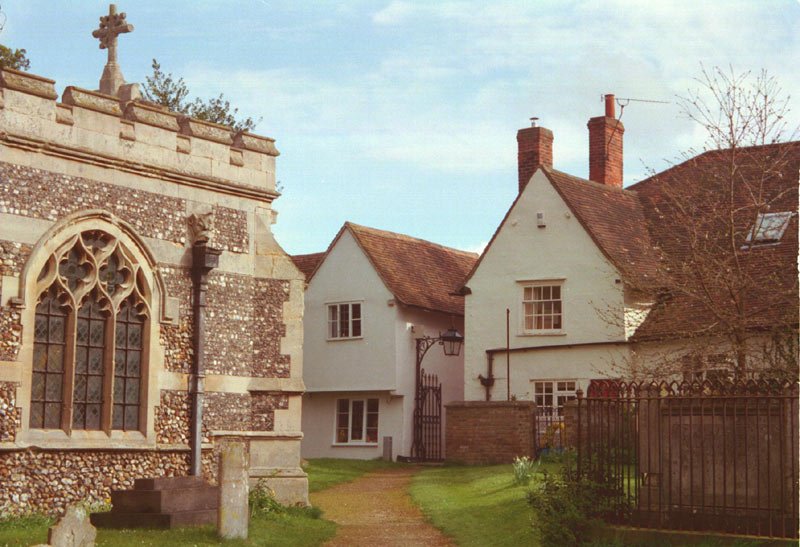
The Essex Way" long distance Footpath 130km (81 miles) crosses Essex and passes through the centre of Great Waltham. The Essex Way starts at the borders of London and Essex at Epping and continues across the county to the historic port of Harwich on the east coast. Great Waltham its self is a popular destination for hikers with many sign posted foot paths. The Parish Council has published several circular walks one of which follows the boundary of the parish approx. 26 km. For details of walking opportunities around Great Waltham and further afield visit Waltham Wanderers web site .
After the second world war 1939 - 1945 Great Waltham village was considerably expanded with the building of local authority housing mainly semi detached and retirement bungalows in what was to become Cherry Garden Road and Duffries Close. Each home was provided with large garden to enable tenants to grow their own vegetables an important economic necessity in austerity Post War Britain.
The change in working patterns from the mid 1950s and the growth in car ownership has brought about a steady decline in the local services and shops. In the past 30 years Great Waltham village, has seen the closure of the butchers, bakery, garage/petrol station, a general store, greengrocers and the Six Bells public house. The village centre has retained the use of fine church which is still used for services, a Primary/Junior School, general store / Sub-Post Office, the Beehive public house, a hair dressing salon and an antique furniture shop the latter was Luckins general store until around 1971.
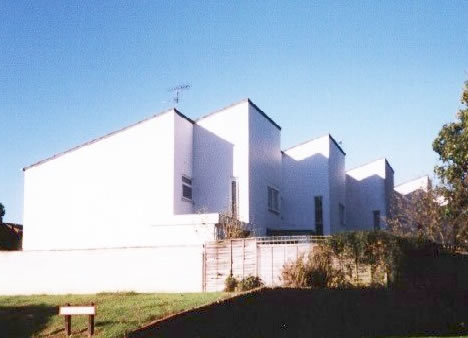 Another major expansion took place between 1967 and 1971 with the building of the "Model Village" a development of ninety, three and four bedroom houses. In the original design the houses all had mono pitch roofs and were painted white but after the completion of the first phase the roofs were changed to a more conventional pitched type taking away striking appearance and much of the character of the houses. Another major expansion took place between 1967 and 1971 with the building of the "Model Village" a development of ninety, three and four bedroom houses. In the original design the houses all had mono pitch roofs and were painted white but after the completion of the first phase the roofs were changed to a more conventional pitched type taking away striking appearance and much of the character of the houses.
This was partly due to the hostility toward the designs from Building Society lenders. This change I believe was detrimental to the original bold concept, had the original design been carried through these houses would be more highly regarded today. The development has large open spaces between the rows of houses with many mature deciduous and pine trees. Roads on the "Model Village" were planted with flowering Cherry trees almost all of these have over the years been removed leaving a very bleak appearance to the street scene. The model village can be seen in at the top of the aerial picture above. In the nineteen seventies two further roads of houses were built adjacent to the "Model village" these had originally been intended to be part of the "Model Village" development but were built in a different style.
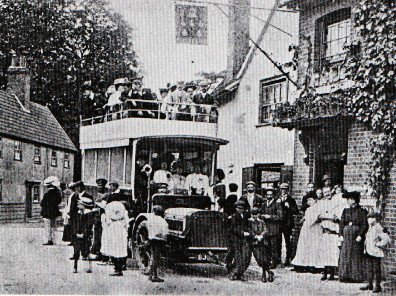 The black and white picture on the right was taken in the early 1900s outside " The Six Bells" public house. The happy villagers appear to be about to depart on an excursion trip. The bus looks like one of the fleet of 12 built by the Great Eastern Railway at Stratford Works in 1904 and operated by that company. The cottages in the background, left side, known as "Ridley's Cottages" were demolished around 1970, the site then became a car park for the pub. The pub, which I always thought was the best in the village is long closed and was divided into three dwellings. The black and white picture on the right was taken in the early 1900s outside " The Six Bells" public house. The happy villagers appear to be about to depart on an excursion trip. The bus looks like one of the fleet of 12 built by the Great Eastern Railway at Stratford Works in 1904 and operated by that company. The cottages in the background, left side, known as "Ridley's Cottages" were demolished around 1970, the site then became a car park for the pub. The pub, which I always thought was the best in the village is long closed and was divided into three dwellings.
Part of the land that formed the car park also has the distinction of being the site of Great Waltham Fire station, during the Second World War a small fire appliance was stationed there. A commemorative plaque recording this was put on the building in 2008.
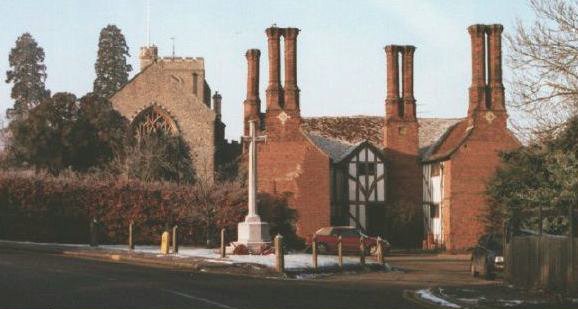
The picture above shows Banbury Square with the village war memorial in the foreground. The memorial commemorates those village men that gave their lives in the two world wars of the last century.
 One of the most notable and distinctive buildings in the village centre is "Badynghams" known locally "The Guildhall" an "E" shaped timber framed house with four sets of distinctive original chimneys. The house has had many alterations throughout its long history but most of what we see today dates from the late 16th to the early 17th century. For many years the building served as the main village store and post office at that time it had a Georgian façade filing the space between the two wings. It was heavily restored to its present state in the 1960s and made into a private house. Since this picture was taken the distinctive black beams and white plaster render have been lime washed in a single flat colour. Shown above One of the most notable and distinctive buildings in the village centre is "Badynghams" known locally "The Guildhall" an "E" shaped timber framed house with four sets of distinctive original chimneys. The house has had many alterations throughout its long history but most of what we see today dates from the late 16th to the early 17th century. For many years the building served as the main village store and post office at that time it had a Georgian façade filing the space between the two wings. It was heavily restored to its present state in the 1960s and made into a private house. Since this picture was taken the distinctive black beams and white plaster render have been lime washed in a single flat colour. Shown above
In July 2014 TV pictures of Great Waltham were beamed around the world when Le Tour de France swept through the parish and village centre.
Picture left a winter scene in late afternoon sunshine after an unusual heavy snow fall near the South lodge to Langleys.
Revised Novemebr 08 2023
|

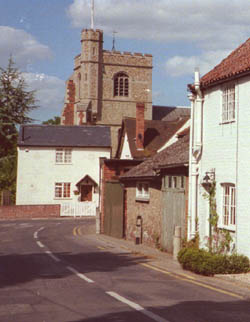
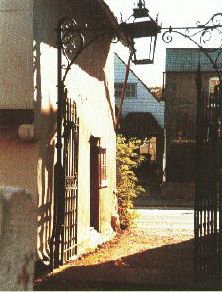 Picture above is the view from the Churchyard onto the main road the lamp was restored as part of the Millennium Celebrations
Picture above is the view from the Churchyard onto the main road the lamp was restored as part of the Millennium Celebrations 
 The Parish of Great Waltham is situated approximately 8 km. north west of the City of Chelmsford, the county city and administrative centre of Essex. The name Waltham is of Saxon origin "walt" meaning "wood" and "ham" meaning "home" literally "wood-home" or home in the wood. During Saxon times much of Essex was covered in dense forest, little now remains of the Essex Forest except Hatfield and Epping forests. The earliest known settlement dates from the Iron Age 300-100 B.C. remains of these early settlements were found in 1971 on the bank of the River Chelmer in what is now Little Waltham. The River Chelmer also runs through Great Waltham linking the two parishes. A large part of the parish lies in the valley of the River Chelmer.
The Parish of Great Waltham is situated approximately 8 km. north west of the City of Chelmsford, the county city and administrative centre of Essex. The name Waltham is of Saxon origin "walt" meaning "wood" and "ham" meaning "home" literally "wood-home" or home in the wood. During Saxon times much of Essex was covered in dense forest, little now remains of the Essex Forest except Hatfield and Epping forests. The earliest known settlement dates from the Iron Age 300-100 B.C. remains of these early settlements were found in 1971 on the bank of the River Chelmer in what is now Little Waltham. The River Chelmer also runs through Great Waltham linking the two parishes. A large part of the parish lies in the valley of the River Chelmer. 


 Another major expansion took place between 1967 and 1971 with the building of the "Model Village" a development of ninety, three and four bedroom houses.
Another major expansion took place between 1967 and 1971 with the building of the "Model Village" a development of ninety, three and four bedroom houses. 

 One of the most notable and distinctive buildings in the village centre is
One of the most notable and distinctive buildings in the village centre is 